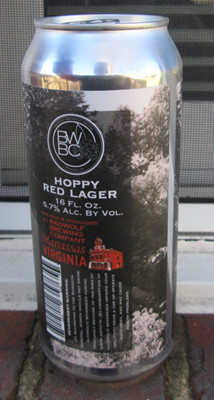Bunnyman (2017)
 |
 |
 |
This month let's look at a can that came out in autumn 2017, a Bunnyman from Bad Wolf Brewing in Manassas, Virginia. First off, who, or what, is The Bunnyman?
Bunnyman is an urban legend from Fairfax County Virginia (where I live). Here is the edited description from Wikipedia.
The first incident was reported the evening of October 19, 1970 by U.S. Air Force Academy Cadet Robert Bennett and his fiancée, who were visiting relatives on Guinea Road in Burke. Around midnight, while returning from a football game, they reportedly parked their car in a field on Guinea Road to "visit an Uncle who lived across the street from where the car was parked". As they sat in the front seat with the motor running, they noticed something moving outside the rear window. Moments later, the front passenger window was smashed, and there was a white-clad figure standing near the broken window. Bennett turned the car around while the man screamed at them about trespassing, including: "You're on private property, and I have your tag number." As they drove down the road, the couple discovered a hatchet on the car floor.
When the police requested a description of the man, Bennett insisted he was wearing a white suit with long bunny ears. However, Bennett's fiancée contested their assailant did not have bunny ears on his head, but was wearing a white capirote of some sort. They both remembered seeing his face clearly, but in the darkness, they could not determine his race. The police returned the hatchet to Bennett after examination. Bennett was required to report the incident upon his return to the Air Force Academy.[citation needed]
The second reported sighting occurred on the evening of October 29, 1970, when construction security guard Paul Phillips approached a man standing on the porch of an unfinished home, in Kings Park West on Guinea Road. Phillips said the man was wearing a gray, black, and white bunny costume, and was about 20 years old, 5 feet 8 inches tall, and weighed about 175 pounds. The man began chopping at a porch post with a long-handled axe, saying: "All you people trespass around here. If you don't get out of here, I'm going to bust you on the head."
The Fairfax County Police opened investigations into the incidents, but both were eventually closed for lack of evidence. In the weeks following the incidents, more than 50 people contacted the police claiming to have seen the "Bunny Man". Several newspapers reported the incident of the "Bunny Man" eating a man's runaway cat, including the following articles in The Washington Post.
"Man in Bunny costume Sought in Fairfax" (October 22, 1970)
"The 'Rabbit' Reappears" (October 31, 1970)
"Bunny Man Seen" (November 4, 1970)
"Bunny Reports Are Multiplying" (November 6, 1970)
The Legend
The Bunnyman legend is a bit different. Again, from Wikipedia.
The legend has circulated for years in several forms. A version naming a suspect and specific location was posted to a website in the late 1990s by a "Timothy C. Forbes". This version states that in 1904, an asylum prison in Clifton, Virginia was shut down by successful petition of the growing population of residents in Fairfax County. During the transfer of inmates to a new facility, one of the fifteen transports crashed; most, including the driver, were killed, ten escaped. A search party found all but one of them.
During this time, locals allegedly began to find hundreds of cleanly skinned, half-eaten carcasses of rabbits hanging from the trees in the surrounding areas. Another search of the area was ordered, and the police located the remains of Marcus Wallster, left in a similar fashion to the rabbit carcasses hanging in a nearby tree or under a bridge overpass—also known as the "Bunny Man Bridge"—along the railroad tracks at Colchester Road. Officials name the last missing inmate, Douglas J. Grifon, as their suspect and call him "the bunny man".
In this version, officials finally manage to locate Grifon but, during their attempt to apprehend him at the overpass, he nearly escapes before being hit by an oncoming train where the original transport crashed. They say after the train passed, the police heard laughter coming from the site. It is eventually revealed that Grifon was institutionalized for killing his family and children on Easter Sunday. For years after the "Bunny Man's" death, in the time approaching Halloween, carcasses are said to be found hanging from the overpass and surrounding areas. A figure is reportedly seen by passersby making their way through the one lane bridge tunnel.
Fairfax County Public Library Archivist/Historian Brian Conley has done a lot of research on this tale, and notes that this version is demonstrably false. Among the problems with the legend.
1. There has never been an asylum for the insane in Fairfax County
2. Lorton Prison didn't come into existence until 1910
3. Lorton Prison was part of the District of Columbia Corrections system, not Virginia's
4. Court records show neither a Grifon nor a Wallster.
Legend-Tripping
I like this can because it reflects "legend-tripping." Many of us have done this, especially when we were young adults or teens. Note: to learn more about “Legend Tripping please check Michael Kinsella’s Legend-Tripping Online: Supernatural Folklore and the Search for Ong’s Hat (University of Mississippi, 2011). I’ve been thinking about legend-tripping and have discussed it in my Public History classes, but Kinsella’s book helped me structure my thoughts on the subject.
Legend tripping involves either going to a location where some sort of supernatural occurred or carrying out a specific performance that according to local legend can trigger a supernatural experience. For our purposes in looking at the Bunnyman can, we’ll stick largely to legend tripping involving a visit to a specific location.
The spot is often a site where some horrible local event supposedly occurred--a murder, a tragic fire, an accidental death. Often these stories involve the death of children or young adults. One famous example I talk about in one of my classes is the Gore Orphanage near Cleveland, Ohio.
It can also be a spot where some otherworldly event is reported to have occurred. The Mothman can from West Virginia references this type of spot. Other common themes include hearing the cries of victims, seeing ghostly lights, strangers appearing then disappearing, killers still stalking the area (usually with a sharp instrument), etc. Movies like the Friday the 13th series play with these stories.
Finally, the location can also be a place with “intrinsic magical ability.” (Kinsella, 28). So-called “Mystery Spots” would fall into this category, where gravity supposedly moves backwards and cars can roll uphill.
Legend-tripping can be a rite of passage, especially for young people. It promotes a sense of community and can be a form of test or trial for those seeking to join a group. (“If you do this, you’ll be one of the ‘cool kids.’”) For example, it’s not uncommon for fraternities to leave their pledges in a graveyard to find their way home. Legend-tripping may be seen in this context as a form of a dare to prove oneself to peers, or would-be peers. We’ll come back to this point in a bit.
Legend-trips for adolescents allow the participants to demonstrate courage in the face of the unknown in what is actually in reality a fairly safe environment (at least in terms of actually raising a monster or some such). It allows them to enjoy their new freedom of movement in a display of independence as the ability to go to prescribed locations which were previously inaccessible.
Legend trips generally follow a pattern, as noted by Kinsella (30). First of a re-telling of the story that set the stage for the trip. There is an “implicit challenge” (30) to the listener in these re-tellings, which may include different variations of the same story. (“Well, what I was told was…”) This stage sets the mood—excitement and anticipation—for the group.
The second stage is the preparation and journey to the site. This stage, in my experience, includes more retellings of the legend and may involve declarations of bravery and further challenges to other members of the group. (“You’re not going to chicken out are you?”)
The third stage is the experience itself at the site. This may or may not include an actual supernatural experience, but it is not uncommon for the participants to convince themselves that they did experience something. (“Did you see that!!?!?”)
Most legend trip stories do not include a prescribed outcome, but the fourth and final stage is a re-telling of the legend by the group once they have returned, often adding to, reinforcing, or reshaping the legend to shape the story to their own experience.
Adults can participate in legend trips as well as a form of “group play.” (31) In my October 2013 COM I briefly discuss how Halloween was becoming an adult holiday. One popular form, the “Ghost Tour,” is increasingly popular among young people and adults alike.
Legend-tripping can also be a form of folk history. I discuss this in my Public History class. The stories that provide the base of the story often involve a local tragedy. The details are generally distorted and embellished which can be a form of distancing oneself from a real tragedy while not forgetting it entirely. The Gore Orphanage story I referenced above did not really occur, but it does reflect an actual tragedy in Cleveland: the Collinwood school fire which erupted on March 4, 1908, and killed 172 students, two teachers, and a rescuer. Likewise, they can be used to focus attention on one aspect of a story while obscuring another. For example, many such stories in the South involve slaves. Tyle Miles’ thought-provoking book, Tales from the Haunted South: Dark Tourism and Memories of Slavery from the Civil War Era (University of North Carolina Press, 2015) discusses how ghost stories involving enslaved persons in Savannah and New Orleans distort the reality of slavery, often emphasizing salacious stories about sex between white male masters and female slaves.
The Bunnyman story, as noted at the top of this page, references and distorts real events. Like other legend trips, it preserves a local narrative in a form that allows members of the community to perform a ritual to create a greater sense of unity around a shared experience.
